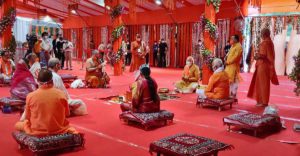Faith the winner in Ram Temple discord

By Vijay Badhwar
Prime Minister Narendra Modi laid the foundation stone of Ram Mandir in Ayodhaya on August 5, on the first anniversary when Jammu and Kashmir was relieved of its special status via Article 370. He must have had a point to make to mark the occasion.
May be to celebrate the resolution of long-lingering issues that no one could take head on for decades. Or that he would lead India on a different course to build a strong nation on majority-willed values rather than prevaricating to placate a section of minority vote bank.
The issue of Ram Janmabhoomi has been complex simply because it is faith-based. How can anyone prove that a mythological character (real for believers) was born at a specific site.
Babri masjid was constructed in 1528-29 by general Mir Baqi, at the instruction of King Babur from Uzbekistan/Afghanistan who had earlier won the battle of Panipat. There are several black kasauti pillars inside the mosque that made Hindus to claim that the mosque was built on top of ruins of a Hindu temple.
According to researcher Valay Singh, a Nihang Sikh claimed the site by building a small Ram Chabutra, according to a complaint filed by caretaker of Babri Masjid, Mohammad Asghar, on November 30,1858. For centuries earlier, there was a vague claim for the birthplace being 40 metres north of the Babri Masjid, later known as Sita Rasoi, as described in a plea made in court.
More than the Janmabhoomi, that was virtually unknown earlier than the 18th century, Hanumangarhi was well established on a hilltop a kilometre away from Babri Masjid site. The secular Awadh king, Wajid Ali Shah, had donated a parcel of land to build the Hanuman Temple for the largely Hindu population in his state.
The minority Muslim community, mostly Sunnis, was unhappy that Hindus were given land to build the Hanuman Temple. Maulvi Ghulam Hussein started spreading the rumours in 1855 that Hanumangarhi was built on the site of an existing mosque. Hindu sects, Ramanandis and Bairagis were deeply divided but joined hands against the Muslims in communal riots to save the temple. The Maulvi followers were outnumbered and fled to take shelter in Babri Masjid.
The riots in 1855 provided an excuse to British East India Company, at the time led by Lord Dalhousie in Calcutta, to annex Awadh and gain a much wanted foothold in India’s north.
In more recent times, former Prime Minister Rajiv Gandhi provided a fresh spark to the Janmabhoomi issue following his earlier highly controversial decision to reverse the court order in Shah Bano case – legislating in parliament that the divorce settlement would be in accordance with the Sharia Law. Then, to strike a balance with the Hindu community, he ordered the locks at the Babri Masjid to be opened.
From then on the Janmabhoomi turned into a political football, a vote bank that could be cashed in through Rath Yatras, notwithstanding the plethora of on-going court cases. Many elections were won and lost; there were chief ministers made and deposed. To keep the two communities at loggerheads was benefitting the politics.
Then came the moment in 1992 that history would remember – kar sewaks climbing on the Masjid domes, demolishing them brick by brick.
Many prime ministers tried to resolve the issue, set up commissions for solutions. But the policy of consensus did not bear fruit. Tough decisions were the call of the day.
After several decades of dithering by the likes of Narasimha Rao, Vajpayee and Manmohan Singh, the hard-liner trio of PM Modi, Home Minister Amit Shah and the Uttar Pradesh Chief Minister Yogi Adityanath entered. The Supreme Court gave permission in November 2019 to build the Ram Temple.
While the first term of the BJP Government was to feel the terrain, the second term exploded with multiple resolutions: ”˜Teen Talaak’, Article 370 and the construction of Ram Mandir at the Janmabhoomi.
The opposition was stunned, cried foul but the Government, enjoying a massive mandate, had stamped its authority. The moment of action came with starting the long-awaited building the temple programme.

On August 5, amidst chanting of Vedic hymns and under a canopy of red, gold and yellow, PM Modi laid a silver brick weighing 40 kilograms. Nine orientation points of the sanctum were marked as soils and holy water from 200 places was used to consecrate the ”˜Bhoomi Puja’ ceremony. 175 dignitaries attended the ceremony, including Chief Minister Yogi Adityanath and Rashtriya Swayamsevak Sevak Chief Mohan Bhagwat.
Mr Modi said that the Temple would be a symbol of unity. “Centuries of waiting is over today. Some people will not be able to believe that they are seeing this during their lifetime,” he said.
The whole town of Ayodhya prepared itself for the big occasion, undergoing a makeover with freshly painted shopfronts in red and yellow and flying saffron flags. A postage stamp was released to mark the occasion.
Large scale developments are in the offing for the town of Ayodhya. Made famous by the scriptures for centuries, the residents will now reap rewards from tourism as a railway station and a airport are in the pipeline.
The Ram Temple is proposed to be nearly 49 metres tall and 85X90 metres in plan area. It will be a symbol of pride not only for Ayodhya but for all India to reflect on values Lord Ram personified.
Short URL: https://indiandownunder.com.au/?p=15381
